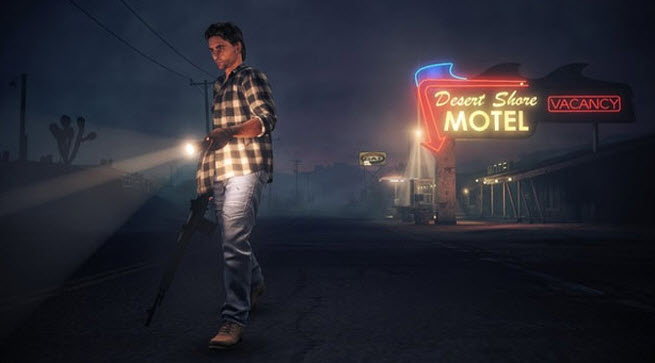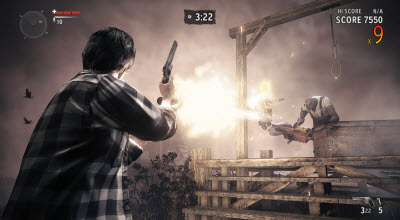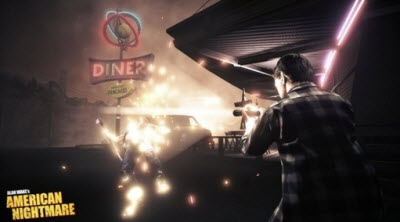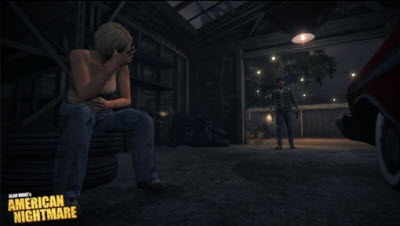 Alan Wake’s American Nightmare is change-up for hardcore fans of Remedy Entertainment‘s story-driven psychological thriller Alan Wake. It is available as an Xbox Live Arcade downloadable title for $15 on the Xbox 360. The experience is a real stand-alone game, but it is not as deep or sophisticated as a $60 console game. It has its own self-contained story and a fun new arcade mode that makes the game play much more enjoyable.
Alan Wake’s American Nightmare is change-up for hardcore fans of Remedy Entertainment‘s story-driven psychological thriller Alan Wake. It is available as an Xbox Live Arcade downloadable title for $15 on the Xbox 360. The experience is a real stand-alone game, but it is not as deep or sophisticated as a $60 console game. It has its own self-contained story and a fun new arcade mode that makes the game play much more enjoyable.
It is a valiant attempt to create a middle space in video games that is sorely lacking. Not everything has to be a blockbuster game or a cheap free-to-play or 99-cent title. Microsoft is publishing a game a month in this new category as part of a special House Party promotion for its downloadable games business on Xbox Live Arcade. Unfortunately, it falls short, even for the reduced expectations I had for a downloadable title. That’s because only part of the shorter game is a lot of fun.
 I was a huge fan of the original Alan Wake, a 2010 release that was so creative I considered it a work of art. The story was mind-bending, revolving around the character of Alan Wake, horror novelist who visits an idyllic town called Bright Falls in the Pacific Northwest in the hopes of exorcising his writer’s block and ends up having his horror novel come to life. His wife disappears, and, in a series of episodes that are like a Twilight Zone-style TV show, Wake has to hunt down the forces of darkness to get her back. He finds he has the power to use light to extinguish the all-too-real nightmare creatures. That original was visually arresting and had an atmosphere that was as creepy as the horror movies and novels that inspired it.
I was a huge fan of the original Alan Wake, a 2010 release that was so creative I considered it a work of art. The story was mind-bending, revolving around the character of Alan Wake, horror novelist who visits an idyllic town called Bright Falls in the Pacific Northwest in the hopes of exorcising his writer’s block and ends up having his horror novel come to life. His wife disappears, and, in a series of episodes that are like a Twilight Zone-style TV show, Wake has to hunt down the forces of darkness to get her back. He finds he has the power to use light to extinguish the all-too-real nightmare creatures. That original was visually arresting and had an atmosphere that was as creepy as the horror movies and novels that inspired it.
As the player, you wielded light against the powers of darkness in thriller story that was part nightmare, part pulp fiction. A flare gun was your best weapon against the possessed human-like demons that hunt you in the darkness. The story borrowed from Stephen King’s Misery novel, the TV show Lost, and David Lynch’s Twin Peaks TV show, but the effect was something altogether original.
In Alan Wake’s American Nightmare, Wake finds himself near a motel on Route 66 in Arizona. After the events of the first game, his wife is once again missing and he has to face his evil twin, Mr. Scratch, a true psycho serial killer who was an urban legend that came to life. Wake has to chase down Mr. Scratch before he unleashes more evil upon the world — and does any harm to Wake’s wife, Alice.
The story mode has about six hours of game play. On top of that, you can play in arcade mode and shoot as many of the evil Taken as you can in 10 minutes (assuming you live that long). The arcade is replayable and gives you many more hours of game play, making the title a bargain for the price. While the arcade mode lives up to its billing, the story mode isn’t quite as fun.
 Some big improvements to the core game play
Some big improvements to the core game play
As we heard in our interviews with Remedy’s chief executive Matias Myllyrinne and franchise development head Oskari “Oz” Hakkinen, gamers complained that the first title’s action sequences got repetitive. That was why, after six years in the making, Alan Wake was a disappointment. It got mostly positive and some mixed reviews, resulting in an average 83 score on Metacritic. It sold more than a million copies, but it could have been so much more.
In creating the new game, Remedy dealt with the criticism head-on. This time, the team created a number of different kinds of so-called Taken foes, who are humans who have turned into creatures of darkness.
The new rivals include fast enemies who wield scythes that can do a lot of damage as they sneak up on your side. It also includes giant tank-like creatures that wield chainsaws and move slowly. The giants take a lot of damage and you usually need something like a flare or a flash bang grenade to hold them back while you empty your gun into them.
The Grenadier is another new threat. It lobs grenades from a distance while other enemies close in on you. That forces you to come out of a defensive mode and chase after the Grenadier. The Splitter is a being that divides itself in two if you shine your flashlight on it to stun it (as you must do with the other Taken). The most dangerous new enemy is a Taken that can transform itself into a flock of crows and vice versa. It takes a lot of time to kill and that means other enemies can surround you as you pursue it.
These new rivals complicate the action. You have to figure out which kind of weapon to use, where to find your extra ammo, and when to run away.
Wake also has a new tactical option: dodging. A slow-motion sequence warns you whenever the Taken are about to attack. If you press the left bumper on the controller, Wake will dodge. With luck, he’ll escape the blow that was about to land on him. That gives the player a new option besides shooting at everything that moves. It also means there is a chance to escape when you are surrounded. If you are surrounded, the usual tactical option is to drop a flare or flash bang. But you can save your flares by simply doing more dodging.
Whereas the original Alan Wake had many more story twists, this game revolves around action. The enemies are wilder and so are the weapons. One of them is a nail gun, which spits out nails at foes that get too close. The action escalates to the point where you really need a big arsenal to finish the job at the end. The inspiration for this game is more like movies such as Grindhouse and From Dusk Till Dawn. Given the criticism of the first game, emphasizing action was a good design decision. If the original game had more of these game play twists, it probably would have gotten a much higher average review score.
This game started out as an arcade-style free-for-all. But Remedy is known for its stories, and its chief storyteller Sam Lake cooked up a story to fit the new style of game play.
The game takes place in Night Springs, a fictional town that was the name of a TV show that Wake wrote before he became a famous novelist. Inspired by the campy Twilight Zone, Night Springs is the setting for the American Nightmare episode where horrors come to life.
In the original Alan Wake, the locals at the town of Bright Falls believed that the writer killed his wife and then died. But much of the stain on Wake’s reputation is the doing of Mr. Scratch, who first appeared in Alan Wake: The Signal downloadable content (DLC) in 2010. Mr. Scratch appears on random TV screens scattered throughout the landscape. He is holding Wake in a kind of existential time trap, akin to the plot of the movie Groundhog Day, where Wake must figure out how to escape the trap and take down Mr. Scratch in order to return to the real world. The doppelgänger wants to take over Wake’s real life and do horrible things to his wife, friends, and reputation.
But Wake is a different man now, not so easily pushed around. A welcome switch in Wake’s personality is his growing sense of confidence in himself. He is no longer having a hard time dealing with the altered reality that he lives in, and he even tries to help other victims caught in the maelstrom to cope with the craziness of “dream logic.” He knows who he is, he knows that he wants to get back to Alice, and he has a better idea of how to attack his enemies. In short, he has figured out that he can rewrite his stories in order to change reality and has assumed his mantle as “The Champion of Light” from the Night Springs script. Along the way, you find the pages of an Alan Wake manuscript that is coming to life.
Wake is upstaged by the crazed Mr. Scratch, the “herald of darkness” who proudly proclaims that the big difference between him and Wake is “I don’t mind being the center of attention.” Of all the things in the game, Mr. Scratch is the most disturbing and a little scary. But one flaw, or benefit, is that you can usually just walk away from the TVs that Mr. Scratch commandeers so he can’t send you his snuff film messages.
The story is simple enough for newcomers to understand. But you have to hunt down a lot of extra content in manuscript pages, radio shows, and interactions with non-player characters. You can go over the same ground more than once — a fact that, as I’ll explain below, the developer takes advantage of — as you search for more clues. You never find the manuscript pages in the right order, so you have to collect a lot of those pages before it all sinks in as a coherent story.
The story takes place across three main locations on Route 66 in Arizona: the Desert Springs Motel, the Mount Redtooth Observatory, and the Night Springs Drive-in theater. They are less linear than the past game and are more open, allowing you to roam over a wider territory. As you do so, you find the first of 53 manuscript pages that convey the background behind the plot.
You start as Wake, awakening in a dark canyon where there is only one way out; it’s hard even for a newcomer to get lost. You have to shine your flashlight on two Taken and shoot them with your handgun. That introduces you to the basics of game play. Then you make your way across an oil field to a motel, where you meet Emma, an attractive blonde mechanic. But the quality-voice acting doesn’t match well with the animation of the characters. Both simply stand there talking, moving only their mouths. It’s the first sign that the investment in the game isn’t as high as it was in the first release. Like other characters you meet later, Emma is a little too taken with the seductive qualities of Mr. Scratch, and she’s sort of disappointed that Wake isn’t the same man. I was just disappointed that it was so obvious Emma was a non-player character.
Wake realizes he has to fight off the Taken around the motel and make his way back to blow up the portal that the Taken are using to enter the area. It’s a fairly pedestrian mission that seems overly simple, given the complexities of the Taken and where the come from. A little too easily, Wake knows exactly what he has to do. And there is no haunting foreshadowing that takes place, as happened in the beginning of the original game.
Once Wake completes that first mission, he goes looking for something else and — presto — you are transformed to the next scene. Even if you weren’t done exploring the motel, you have no choice; you are transported to the next battleground between light and darkness. From then on, you get caught in the time whirlpool that takes you back to the same three locations over and over until you break free of the trap.


